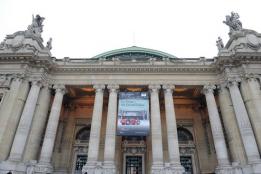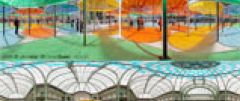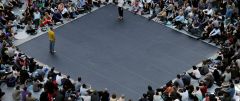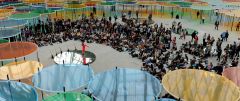Entrée principale de la nef du Grand Palais. Photo Didier Plowy.
Brief comments
As this text was written more than two months before the installation, it gives the broad outlines but omits details which may prove important.
• Entering the nave by the north should avoid the difficulty caused by the usual main entrance (on the east side of the building), which projects visitors into the centre of the space and renders the rest of the exhibition almost secondary. Besides, this door is probably the least interesting element in the whole building, because it is so pompous, disproportionate and heavy. It is so massive that it seems to replace the entire east bay, which it should open on to, and which, in fact, does not exist; hence the very uncomfortable feeling of entering a place which seems unfinished and yet offers a sort of apotheosis even before its full measure can be taken. This entrance is also in complete visual contradiction with the extraordinary finesse of the nave itself, which is twenty times larger but so much lighter and finer.
• Visitors will therefore have to walk down the whole length of the building and discover the central area from a different angle.
• This space, left empty because of the “hole” in the systematic covering of the area, suggests an enormous cylinder, 32 m in diameter, going right up to the dome, which, as it closes over the top, can be imagined as a sort of hot-air balloon rising into the sky.
• Although the circles are covered with a coloured film, they are completely transparent and therefore reveal the enormous volume above the visitors’ heads. As the visitors walk along, the architecture turns blue or yellow or orange or green. Through the small triangular spaces between the circles, they catch a glimpse of the real colour of the building and can compare it with the coloured impression given by the transparent circles.
• The nave of the Grand Palais, where Monumenta is held, is an enormous public place where people can wander about, meet friends, talk, stroll, stop for a while… Inside the exhibition itself, visitors can buy sandwiches, drink a cup of coffee, leaf through or buy books, sit or lie down, run about, take photographs…
• In this great nave, the sky is more important than the walls, hence the search for a work that proceeds directly from this feature and accentuates its effects as much as possible.
• As with all my work in a public space, the night lighting does not attempt to recreate the effect of daylight.
On the contrary, it is specific lighting designed to transform the diurnal work, in the light of day, into a nocturnal work, lit by electricity.
Daniel Buren
Paris, 5 March







 Grand Palais
Grand Palais